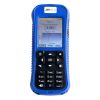Global Water Flow Probes
The Global Water Flow Probes are an accurate water velocity instrument for measuring flows in open channels and partially filled pipes.
Features
- Used to measure flows in open channels & partially filled pipes
- Consists of a turbo propeller type sensor on an extendable handle
- Incorporates velocity averaging & is ideal for many environmental applications
- Free ground shipping
- Expedited repair and warranty service
- Lifetime technical support
- More
Overview
The Global Water Flow Probe is an accurate water velocity instrument for measuring flows in open channels and partially filled pipes. The water velocity probe consists of a protected water propeller with a positive displacement sensor coupled with an expandable probe handle ending in a digital readout display. The water flow meter incorporates true velocity averaging for accurate flow measurements.
Swivel Head Option
The Flow Probe is ideal for stormwater runoff studies, sewer flow measurements, measuring flows in rivers and streams, and monitoring water velocity in ditches and canals. The Flow Probe Swivel Head option allows rotation of the flow probe's turbo-prop up to + 90 degrees from its standard position. This option lets the flow probe take water velocity measurements in hard-to-measure areas such as vertical pipes on water tanks or swimming pool drainage systems.
Turbo-Prop Propeller Sensor
Uses the most accurate positive displacement technique available for velocity sensing. The Turbo-Prop is designed to shed debris and is protected inside a 2" diameter housing. The probe housing may be placed directly on the bottom of a pipe or stream bed for measuring low flows down to 2" in depth. The flow meter propeller rotates freely on its bearing shaft with no mechanical interconnections for minimal friction. Magnetic material in the propeller tip passes a pickup point in the water velocity meter handle producing electrical impulses that are carried to the readout display by an internal cable. The Turbo-Prop is easily removed for cleaning or replacement.
Automatic Conversion
The water velocity computer receives an electrical signal from the propeller, amplifies the signal, and converts the reading to feet per second (or meters per second, depending on programming). The large LCD screen displays average, minimum, and maximum water velocity readings. Up to 30 sets of time and date stamped data points can be stored in the computer with the push of a button. These data points can be reviewed on the computer screen for later analysis. The water velocity computer has a water-resistant housing and incorporates a unique four-button operation for changing functions and resetting the display. The water velocity computer is powered by a non-replaceable battery that will last approximately five years with normal use. Low battery and end of data warnings will also display as appropriate.
- Range: 0.3-19.9 FPS (0.1-6.1 MPS)
- Accuracy: 0.1 FPS
- Averaging: True digital running average. Updated once per second.
- Display: LCD, Glare and UV Protected
- Control: 4 button
- Data Logger: 30 time and date stamped data sets
- Power: Internal Lithium Battery, Approx 5 year life, Non-Replaceable
- Operating Temperature: -4 to 158 F (-20 to 70 C)
- Storage Temperature: -22 to 176 F (-30 to 80 C)
- Carrying Case: The Flow Probe is shipped in a padded carrying case
- Approvals: CE
- (1) Flow probe
- (1) Carrying case
In The News
Protecting Streams From Groundwater Withdrawal Effects
The Water Withdrawal Assessment Tool (WWAT), developed by the Michigan Department of Environmental Quality, is an important tool for predicting the impacts of withdrawing water to streams. It is used throughout the state by environmental organizations concerned with stream health for a variety of reasons. The Michigan chapter of Trout Unlimited is one example of an organization that uses the WWAT in its work to help the state’s coldwater fisheries and watersheds. But since the assessment tool provides only an estimate of what base flows are, it’s important for volunteers with the organization to test and verify actual measurements from the field before making management decisions.
Read MoreGlobal Water Flow Probe: Water velocity measurements from an all-in-one instrument
Standing in the middle of a waist-high stream, leaning against a steady current is the last place where one wants to be sorting out cumbersome equipment to take water velocity measurements. The Global Water Flow Probe eliminates any in-stream complications with an integrated design to keep researchers measuring with ease. Global Water was founded on a water velocity meter. Creator John Dickerman wanted to provide an all-in-one measuring system. The latest result is a device users can simply dip it in the water and record velocity readings. The instrument has no wires, headphones or controller boxes to connect. There is just a probe at the bottom and a computer mounted on top.
Read MoreRounded pebbles give evidence of past flowing water on Mars
NASA's Curiosity rover has found pebbles that appear to have been rounded by streamflow, according to a release from University of California Davis. Experts say the finding represents the first on-site evidence of sustained flowing water on Mars. The rounded pebbles discovered are only known to form when transported through water over long distances. Their discovery supports theories that the red planet could once have supported life. The smooth rocks were found between the north rim of the planet’s Gale Crater and the base of Mount Sharp, a mountain inside the crater. Researchers say they chose Gale Crater for study because there was a sediment deposit there that typically requires water to form.
Read More











